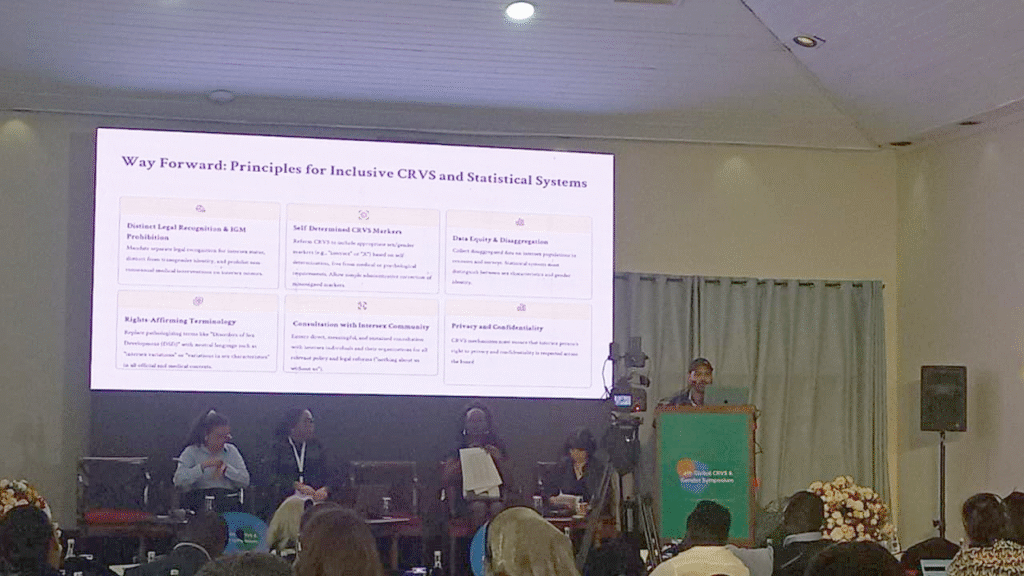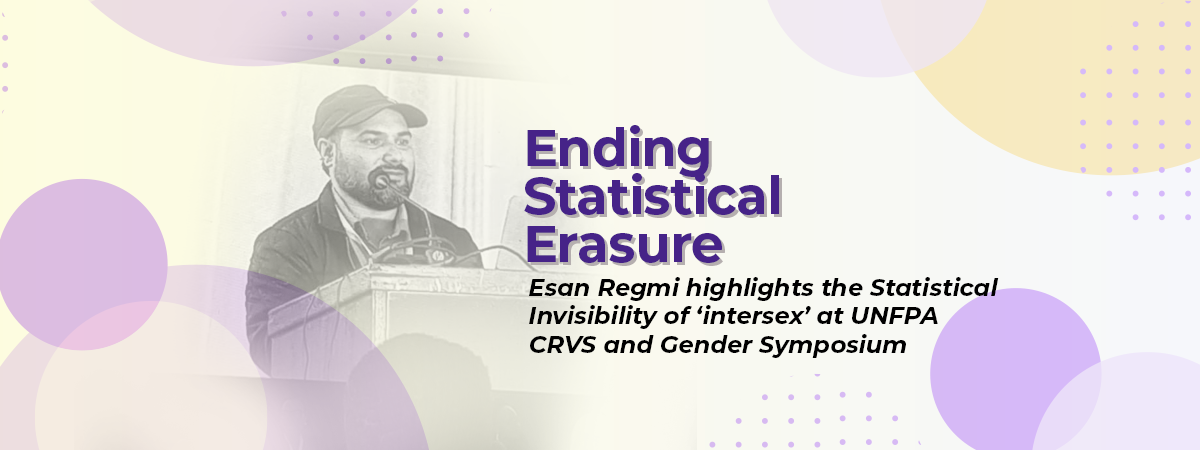Intersex Asia (IA) is proud to spotlight the vital advocacy work carried out by Esan Regmi- our Chair and Executive Director of Campaign for Change in Nepal, who presented key research findings on intersex inclusion in Civil Registration and Vital Statistics (CRVS) systems at a recent high-level Gender and CRVS symposium organised by UNFPA in Nairobi, Kenya between October 15-17, 2025. This participation underscored the urgent need to address the systemic statistical invisibility of intersex people across Asia.
The Session and Presentation: Addressing Data Gaps
Esan Regmi’s participation focused on the critical relationship between legal recognition and accurate data collection for the intersex community. The core theme of the discussion revolved around the need for robust data systems that accurately reflect the existence and needs of intersex persons. Specifically focused on the South-Asian context, Esan’s presentation tackled pervasive challenges related to how states categorize or fail to categorize intersex individuals within CRVS systems and national censuses.
Key Points from the Presentation
The presentation emphasized that for intersex people, exclusion from or misrepresentation within CRVS systems leads to a cascade of human rights denials and hinders full societal participation. Key points raised concerning statistical invisibility and legal confusion include:
- The Problem of Misclassification: In many Asian countries, intersex individuals are often incorrectly grouped under broad categories such as “third gender,” “transgender,” or “other” in legal and statistical systems. This grouping ultimately obscures the distinct biological realities and human rights concerns of intersex people.
- The Inaccurate Identity Marker: In the presentation, Esan affirmed that the “true identity of an intersex child is intersex, not ‘other,’ ‘undetermined,’ or ‘third gender'”. Using ambiguous categories fails to affirm the individual’s intersex status and prevents the collection of accurate prevalence data.
- Policy gaps due to Invisibility: The systematic absence of specific, disaggregated data pertaining to intersex people renders their unique needs, vulnerabilities, and experiences invisible to policymakers. Without data, the government cannot formulate targeted and effective programs for health, education, employment, and safety.
- CRVS as a Gateway to Rights: Accurate and appropriate identity documents, secured through CRVS systems, are essential gateways for accessing fundamental human rights and services, including healthcare, education, and employment. Without proper registration, children cannot enroll in school, claim inheritance, or receive government services.
- Need for Specific Legal Frameworks: Esan, drawing on the situation in Nepal, specifically highlighted that the lack of disaggregated data hampers the government’s ability to formulate targeted policies to address the specific health, social, and economic needs of intersex individuals.
Building on Intersex Asia’s Foundational Work

Esan’s participation and presentation directly reinforce and amplify the core findings and advocacy goals articulated through Intersex Asia’s previous work on legal identity and data inclusion. Intersex Asia has conducted extensive research, producing reports that examine the situation in twelve Asian countries (including Nepal, India, and Pakistan), consistently finding a serious lack of specific legal recognition for intersex people. IA’s research confirms that legal and statistical systems often conflate intersex individuals with transgender people or ill-defined “third gender” categories, perpetuating invisibility.
Intersex Asia has continually underscored that inclusion in CRVS mechanisms and official statistics is critical for achieving broader human rights for intersex people. This focus is essential because CRVS systems form the bedrock of an individual’s legal identity. Specifically, this participation advances Intersex Asia’s calls for urgent reforms, including:
- Seeking distinct legal recognition of intersex status, separate from gender identity categories.
- Advocating for the inclusion of appropriate sex/gender markers (such as “intersex” or “X”) in CRVS systems based on self-determination.
- Demanding the collection of disaggregated data on intersex populations in censuses and national surveys to move from invisibility to evidence-based governance.
Reflecting on his experience, Esan remarked: “It was a crucial opportunity to advocate for intersex inclusion in global data systems. As the only panelist to explicitly address intersex beyond binary categories, I highlighted how current CRVS frameworks erase intersex identities, impacting legal recognition and access to services. I noted with concern the absence of intersex-specific issues in broader CRVS discussions, which were predominantly binary. There was no substantive discussion on rights-based, trauma-informed reforms for birth registration or data systems to respectfully include intersex persons. This gap underscores the urgent need for continued advocacy to ensure intersex visibility in foundational legal identity systems.”By highlighting how the lack of proper CRVS registration actively hinders intersex people’s development and access to basic rights, Esan’s remarks highlighted the need to strategically leverage the findings of Intersex Asia’s regional analyses to demand system-wide changes. He contributed significantly to discussions aimed at fostering inclusivity within governmental systems, emphasizing that accurate representation is crucial for informed policymaking. By highlighting these issues on an international stage, IA reaffirms its commitment to advancing human rights for intersex individuals across the region.The goal is to ensure that intersex individuals are not only visible but are also counted, respected, and guaranteed their fundamental human rights.




